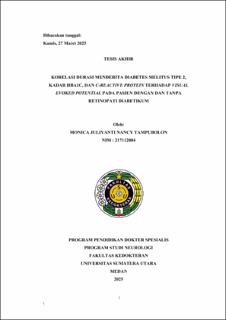Korelasi Durasi Menderita DM Tipe 2, Kadar HbA1c, dan C-Reactive Protein Terhadap Visual Evoked Potential Pada Pasien Dengan dan Tanpa Retinopati Diabetikum
The Correlation Between Duration of Type 2 DM, HbA1c, and C-Reactive Protein Levels With Visual Evoked Potential In Patients With and Without Retinopathy Diabeticum

Date
2025Author
Tampubolon, Monica Juliyanti Nancy
Advisor(s)
Iqbal, Kiki Mohammad
Fitri, Aida
Syafril, Santi
Metadata
Show full item recordAbstract
Background: Diabetic retinopathy is an ocular manifestation of target organ damage in diabetes mellitus. Some risk factors for diabetic retinopathy include disease duration, chronic hyperglycemia, and inflammation. Visual evoked potential (VEP) is an electrical potential recorded from the scalp above the visual cortex, which is obtained by visual stimulation. VEP abnormalities in patients with type 2 DM are indicated by prolonged P100 latency. VEP examination is thought to be more sensitive to changes in the retina and optic nerve as an early detection of diabetic retinopathy.
Purpose: To determine the correlation between disease duration, HbA1C, and Creactive protein with VEP in patients with and without diabetic retinopathy.
Method: This study is an observational analytical study with a cross-sectional data collection method on 20 patients with type 2 DM with diabetic retinopathy and 20 patients with type 2 DM without diabetic retinopathy. To determine the differences in clinical characteristics in the two groups, the independent t test or Mann-Whitney test was used. To determine the correlation between the disease duration, HbA1C, and C-reactive protein with VEP in patients with and without diabetic retinopathy, the Pearson or Spearman test was performed.
Results: There was a difference in VEP in patients with and without diabetic retinopathy in both eyes (p<0.05). There was a significant correlation between disease duration and VEP in the diabetic retinopathy group (right eye: p=0.021, r=0.512; left eye: p=0.028, r=0.491) and without diabetic retinopathy (right eye: p=0.031, r=0.484; left eye: p=0.037, r=0.470). There was a significant correlation between HbA1c and VEP in the diabetic retinopathy group (right eye: p=0.037, r=0.470; left eye: p=0.038, r=0.467) and without diabetic retinopathy (right eye: p=0.013, r=0.546; left eye: p=0.041, r=0.461). There was no correlation between CRP values and VEP in the groups in both groups (p>0.05).
Conclusion: There was a significant difference in P100 latency in patients with and without diabetic retinopathy. Disease duration and HbA1c values were correlated with prolonged P100 latency, but not with CRP levels.
Collections
- Master Theses [156]
